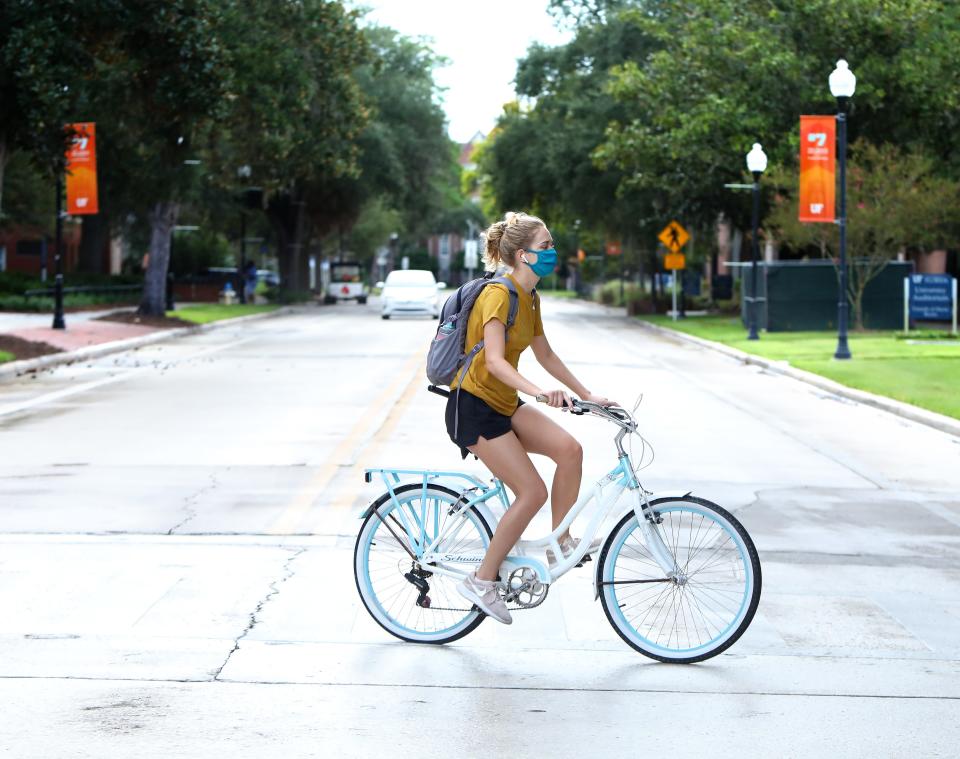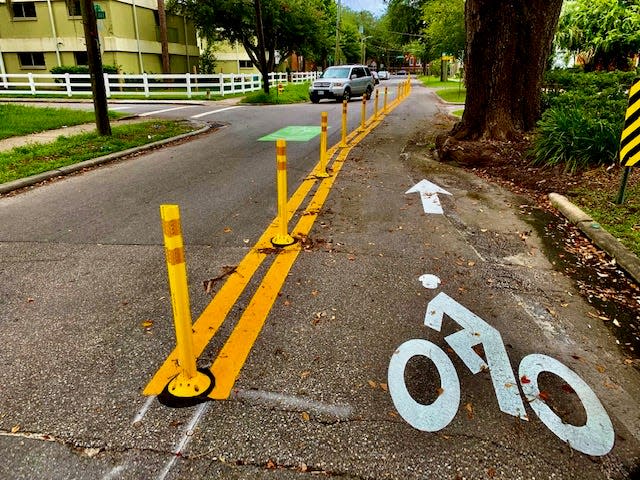Install protected bike lanes around the University of Florida campus
At the University of Florida, where students can choose to live on or off campus, safely commuting to campus is essential. Students often use cars or buses for transportation since they are safer and quicker.
However, dependency on cars or buses negatively impacts the environment through excessive greenhouse gas emissions, meaning that not being able to get to class by cycling, a more environmentally conscious method of transportation, only exacerbates the emission rate.
While UF provides a multi-story parking garage, various parking lots around dormitories and fare-free Regional Transit System transportation for students, there is little encouragement for students to reduce their carbon footprint by cycling. Although UF has an ample amount of bike racks, students who reside off campus find it dangerous to cycle since they must do so using main roads with few bike lanes and a lack of protective barriers.

Students must largely cycle on pedestrian sidewalks, meaning cyclists encounter both vehicular and pedestrian traffic on their commute. In other words, students are prevented from not only purchasing bicycles, but also using the ones they own.
Not using a bicycle also deters students from becoming more physically active. In fact, regularly cycling results in physical and mental benefits such as increased cardiovascular health and reduced anxiety, respectively. For students with leadership positions, demanding academics or various across extracurriculars across campus, cycling can therefore minimize the risk of contracting or heightening feelings of anxiety, stress and depression.
On my UF in Europe study abroad program, I witnessed small and large cities advocate for their citizens to use bicycles. In fact, the centralization in European cities I visited and Gainesville is extremely similar, with necessary locations such as hospitals, banks, supermarkets and even clothing outlets being accessible to each other.
However, the difference lay in the way in which citizens would get to these places, with many Europeans cycling compared to Gainesville students’ reliance primarily on cars. Because there was not only a designated bike lane on major roads but also elevated concrete which served as a barrier between cars, bicycles and pedestrians, people were able to feel safe riding their bicycles to anywhere in their city.
In order to encourage students to rely on cycling to get to campus and therefore reduce their carbon footprint, UF must coordinate with the city of Gainesville to construct bike lanes along main roads including Archer Road and West and East University Avenue. To add an extra layer of protection from vehicles, barricades must also be constructed to mitigate concerns about cars irresponsibly drifting into bicycle lanes.

Installment of the barricades would encourage the use of bicycles since there are now two layers of security: a designated bike lane and barricades. Besides students feeling shielded from dangers of the road, parents of incoming students that assist them in choosing transportation methods may feel inclined to acquire a bicycle for their child.
Since bicycles are cheaper than cars, and more reliable than buses since one can control when and where they ride their bicycle, parents and students may prefer to buy one instead of the alternative: driving one’s car to Gainesville or relying on a bus that may or may not arrive on schedule.
Apart from being cheaper and more reliable, choosing bicycles instead of other forms of transport has various benefits, most notably reducing carbon emissions of up to 7.7 million tons annually in countries like the United Kingdom. Even when considering other forms of emissions in forms of transportation such as walking or riding a bus, cycling has the lowest form of carbon footprint emission.
Besides reducing carbon emissions, riding bicycles instead of pursuing a sedentary lifestyle has been linked to increased life expectancy. Since air particulate matter takes over two years off someone’s lifespan, pursuing methods of transportation that reduce greenhouse gas emissions would allow global citizens to experience longer lifespans due to better air quality.
Despite Gainesville being a college town, it also has a large population of almost 16,000 elderly residents that are at risk of premature death due to decreased air quality. Therefore, aiming to reduce one’s carbon footprint by pursuing more sustainable methods of transportation would also reduce chances of elderly residents suffering due to excessive amounts of particular matter.
My proposal would be to create a two-mile radius of protected bike paths around UF along such roads as Archer Road and University Avenue. Both the city of Gainesville and UF would collaborate in constructing a bike path between car lanes and the sidewalk, and installing bike path barricades until cyclists arrive at campus.
To make cyclists aware of the new safety measures implemented and encourage them to cycle, bike shops would ideally advertise the use of the paths to customers through methods such as flyers, word of mouth or even a store discount.
An example of the efficiency of bike paths in action can be found at the University of Edinburgh, which has undergone the process of creating safe cycling conditions through cyclist training and construction of bicycle facilities. Through this, it has been named the best university for student cyclists in the U.K.
Its approach consists of normalizing cycling culture and engaging students through improved infrastructure and increased accessibility of bicycle lanes. The University of Edinburgh’s success can serve as an example to UF since besides improving existing infrastructure, cycling programs such as the Bicycle Pedestrian Program in Gainesville and Florida Pedbike Resource Center and Gator Gears at UF would motivate students to utilize their bicycles.
The result of urging students to familiarize themselves with initiatives intended to make cycling a safer and more common practice would be not only a reduction in greenhouse gases emitted by UF, but also a more physically active student body.
Therefore, besides giving students a way to access campus from up to two miles away, the installation of bike paths would give students an incentive to reduce their carbon emissions. With less reliance on cars or buses, and a greater percentage of the student population using bicycles to get around, UF can adhere to its promise to provide a safe environment for students while promoting sustainable values both on and off campus.
Olivia Maule is a biology major at UF, with a minor in sustainability.
Join the conversation
Share your opinions by sending a letter to the editor (up to 200 words) to letters@gainesville.com. Letters must include the writer's full name and city of residence. Additional guidelines for submitting letters and longer guest columns can be found at bit.ly/sunopinionguidelines.
Journalism matters. Your support matters.
Get a digital subscription to the Gainesville Sun. Includes must-see content on Gainesville.com and Gatorsports.com, breaking news and updates on all your devices, and access to the eEdition. Visit www.gainesville.com/subscribenow to sign up.
This article originally appeared on The Gainesville Sun: Olivia Maule: Install protected bike lanes around the UF campus

